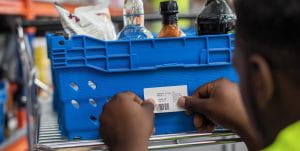How to increase supply chain visibility with QR codes

Since the inception of the QR code in 1994, businesses have increasingly adopted this technology in order to make tracing and information storing easy across supply chains.
Barcodes – the king of universal product identification – still have a plethora of uses across a number of industries. This versatile technology isn’t going anywhere as billions of items are scanned daily across every vertical of business worldwide. However, increasing manufacturing speed and advancing technology saw the need for a new form of inventory tracking in the early 2000s, and many businesses began to adopt QR codes as a result.
QR codes have developed to play a supporting role for barcoded products thanks to a variety of applications, from linking to additional website information or how-to-videos to providing additional tracking details.
Supply chains around the world have faced significant logistics disruptions and production delays. Some reports indicate that local supply chains will continue facing challenges, placing an increased focus on demand for end-to-end visibility that QR codes can help provide.
By storing large amounts of information on a single code, distribution records, logs and inventory details can be affixed to products that can be scanned from anywhere along its journey to a consumer’s front door.
This article will examine how implementing QR codes can improve the traceability of your products across the supply chain.
 Keeping track of exponentially growing online purchases requires solutions that
can scale as a business grows
Keeping track of exponentially growing online purchases requires solutions that
can scale as a business growsQR codes for asset tracking
Many Australian businesses are relying on outdated workflows for their essential labelling processes. This inefficiency results in overburdened budgets, the misuse of office equipment and slowed production times.
The 7,000-character capacity of a single QR code can allow a wealth of information to be accessed with a single scan. Organisations are storing everything from instruction manuals to regulatory compliance information on QRs that are accessible to employees. QR codes can offer discounts and additional product information to end users who access information via their smartphone cameras. When it comes to supporting transparency across the supply chain, these versatile solutions can play a key role.
Here’s how QR codes can assist your asset tracking:
- Organise your inventory: Transitioning from a legacy inventory system involves the removal of old labels and systems of tracking. Your ideal process will involve a QR label printed from an industrial label printer like the TJ-4420TN that contains all relevant product information on one code. Information should include purchase date, location, current condition and value – as well as maintenance schedule and repair history, if applicable. Annual reconciliation and regulatory compliance data can also be stored on a single QR code
- Track your labels: The versatility of a cloud-based data management system allows any authorised personnel instant access to the real-time status, location and future shipping or delivery information regarding your newly tagged resources and assets
- Reinforce label strength: Brother P-touch TZe tapes provide weather and water-resistant labels you can count on
QR codes for freight management
The volume of products being manufactured and shipped – combined with a surge in consumer demand – has increased the operational requirements on freight management systems. Keeping track of exponentially growing online purchases requires dexterity and traceability solutions that can scale as a business grows.
Australia Post reported that online purchases increased by a staggering 73.1% from 2019 to 2021, highlighting a shift in consumer behaviour since the pandemic began. In order to keep up with the demand, your freight management processes need to be efficient – and fast.
Here’s how you can integrate QR technology into your freight management system:
- In the warehouse: Mobile print technologies like the RJ-3250WB help deliver QR-enhanced shipping documents on the go. What’s more, hassle-free thermal printing technology means you can print ink-free. The high-volume print capabilities of the portable RJ-4230B help deliver your information quickly and efficiently
- At the door: Once delivered, consumers can scan QR labels affixed to their products with their smartphones in order to view everything from instruction manuals to ingredient contents and nutritional information
 For accurate asset tracking, use a thermal
label printer to print QR labels that contain all relevant product information in one code
For accurate asset tracking, use a thermal
label printer to print QR labels that contain all relevant product information in one codeQR codes for supply chain resilience
QR technology increases efficiency all along the supply chain. The implementation of a QR solution can help with everything from warehouse routing to re-shipping.
In the case of product returns, QR codes can provide easy access to connected inventory management portals. As soon as an attempted delivery is made, the scan of a QR code links through to tracking systems that can be amended to include any necessary additional information regarding the attempted delivery.
Back at the warehouse, forklift drivers have a clear line of sight into the exact delivery times and locations for storing returned merchandise, thanks to the connectivity provided by a Brother Software Development Kit (SDK) that integrates seamlessly with your software architecture. SDKs can process the updated information from your QR-powered supply chain, ensuring the traceability today’s business world demands.
Brother solutions
From the warehouse to the front door, QR scanning provides real-time data and logistics details, updates and information – improving the supply chain process from end to end. To get started with a Brother QR code solution, contact us today.

Resource Library
Be the first to receive exclusive offers and the latest news on our products and services directly in your inbox




